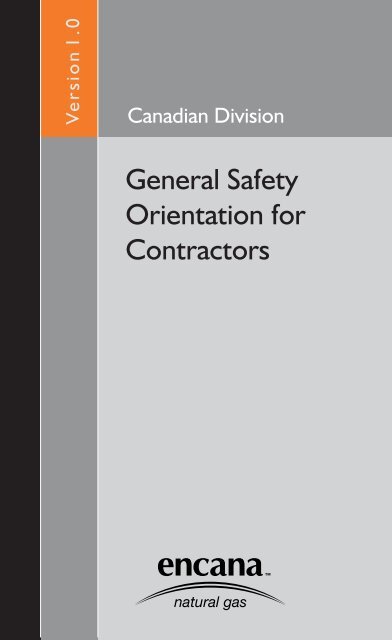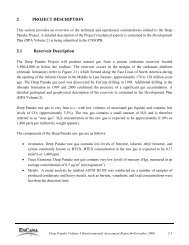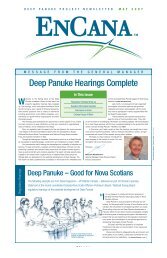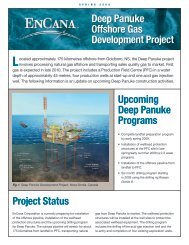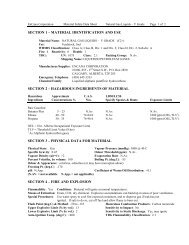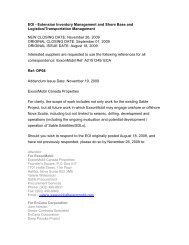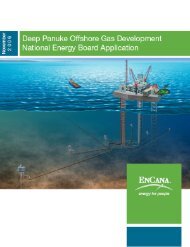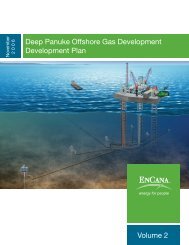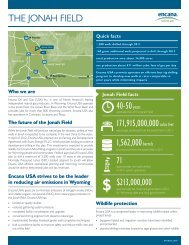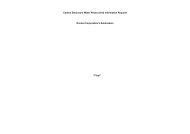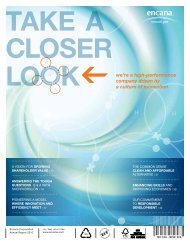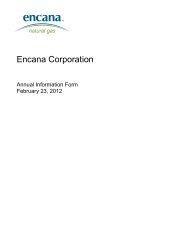General Safety Orientation for Contractors - Encana
General Safety Orientation for Contractors - Encana
General Safety Orientation for Contractors - Encana
Create successful ePaper yourself
Turn your PDF publications into a flip-book with our unique Google optimized e-Paper software.
Ve r s i o n 1 . 0<br />
Canadian Division<br />
<strong>General</strong> <strong>Safety</strong><br />
<strong>Orientation</strong> <strong>for</strong><br />
<strong>Contractors</strong>
R<br />
<strong>General</strong> <strong>Safety</strong> <strong>Orientation</strong> <strong>for</strong> <strong>Contractors</strong><br />
Table of Contents<br />
Note: Revisions are indicated by the symbol<br />
in the left margin.<br />
Definitions ........................................................................ 5<br />
Purpose/Foreword ........................................................... 6<br />
<strong>Encana</strong> Corporate Constitution...................................... 7<br />
<strong>Encana</strong> Corporate Responsibility Policy....................... 7<br />
(EH&S) Principles ............................................................ 8<br />
Contractor Practice.........................................................10<br />
R 1.0 Contractor Selection ...........................................10<br />
R 1.1 Agreement with Incorporated Entities.................10<br />
R<br />
1.2 Periodic Reviews ................................................11<br />
Regulations .....................................................................12<br />
2.0 Occupational Health and <strong>Safety</strong> Act and<br />
<strong>General</strong> <strong>Safety</strong> Regulation .................................12<br />
2.1 <strong>Encana</strong>’s Responsibilities...................................12<br />
2.2 Contractor Company and Contractor<br />
Employee Responsibilities..................................12<br />
2.3 Contractor Employee Training............................14<br />
2.4 Right to Refuse Work – Imminent Danger ..........14<br />
2.5 Working Alone ....................................................15<br />
3.0 Workers’ Compensation Legislation ...................15<br />
3.1 Reporting of Work-Related Injuries or Illnesses..15<br />
3.2 Insurance Coverage ...........................................15<br />
3.3 Return to Work Programs...................................15<br />
4.0 Workplace Hazardous Materials In<strong>for</strong>mation<br />
System (WHMIS)................................................16<br />
4.1 Responsibilities of Employers and Employees ...16<br />
5.0 Transportation of Dangerous Goods (TDG) .......16<br />
5.1 Responsibilities of Employers and Employees ...16<br />
-1-<br />
R
Hazard Management.......................................................16<br />
6.0 Hazard Identification........................................16<br />
6.1 Type of Hazards ..............................................17<br />
6.2 Methods <strong>for</strong> Identification ................................17<br />
7.0 Hazard Assessment ........................................17<br />
8.0 Hazard Control ................................................18<br />
8.1 Types of Control Measures .............................18<br />
Personal Protective Equipment (PPE) ..........................18<br />
9.0 Common Types of PPE...................................18<br />
10.0 Respiratory Protection.....................................20<br />
10.1 Gases, Fumes and Dust..................................20<br />
10.2 Respiratory Protection Programs ....................21<br />
10.3 Gas Detection and Monitoring .........................21<br />
Safe Work Practices .......................................................22<br />
11.0 Safe Work Procedures ....................................22<br />
12.0 Permitting Systems .........................................22<br />
12.1 Different Types ................................................22<br />
13.0 Lockout and Tagout Systems ..........................23<br />
13.1 De-energizing Systems ...................................23<br />
14.0 Equipment Isolation.........................................23<br />
14.1 Purging and Blinding .......................................23<br />
R 15.0 Fire and Explosion Hazard Management ........24<br />
R<br />
15.1 Critical Risk Factors ........................................24<br />
16.0 Fire Prevention and Fire Extinguishers ...........25<br />
16.1 Fire Prevention ................................................25<br />
16.2 Fire Extinguishers............................................25<br />
17.0 Scaffolding.......................................................25<br />
17.1 Regulations .....................................................25<br />
17.2 Tagging ...........................................................25<br />
18.0 Excavation and Trenching...............................26<br />
18.1 Regulations .....................................................26<br />
19.0 Working at Heights ..........................................26<br />
19.1 Regulations .....................................................26<br />
19.2 Fall Protection .................................................26<br />
Version 1.0<br />
-2-
R<br />
R<br />
R<br />
<strong>General</strong> <strong>Safety</strong> <strong>Orientation</strong> <strong>for</strong> <strong>Contractors</strong><br />
20.0 Welding and Cutting ........................................27<br />
20.1 <strong>Safety</strong> Watch ...................................................27<br />
20.2 Welding Hazards .............................................27<br />
21.0 Hot Work..........................................................27<br />
22.0 Driving .............................................................28<br />
23.0 Electricity and Electrical Equipment.................28<br />
24.0 Electronic Devices in Hazardous Areas...........31<br />
Common Workplace Hazards and Controls .................32<br />
25.0 Vehicles ...........................................................32<br />
26.0 Heavy Equipment ............................................32<br />
27.0 Lifting ...............................................................33<br />
28.0 Tools................................................................33<br />
29.0 Ladders............................................................33<br />
30.0 Compressed Air...............................................34<br />
31.0 Compressed Gas Cylinders.............................34<br />
32.0 Housekeeping..................................................34<br />
33.0 Smoking...........................................................35<br />
34.0 Impairment – Alcohol, Drugs and Fatigue........35<br />
35.0 Ergonomic Hazards .........................................35<br />
36.0 Danger Trees...................................................36<br />
37.0 Diesel Engines.................................................37<br />
38.0 Firearms ..........................................................37<br />
39.0 Pets .................................................................37<br />
40.0 NORM..............................................................37<br />
R 41.0 Public Relations...............................................38<br />
R 42.0 Security (trespass)...........................................39<br />
Common Oil and Gas Industry Hazards and Controls 40<br />
44.0 Portable Heaters..............................................40<br />
45.0 Pipe Handling ..................................................40<br />
46.0 Winching/Towing .............................................41<br />
47.0 Valves..............................................................41<br />
R 48.0 Overhead Lines ...............................................42<br />
49.0 Underground Lines ..........................................44<br />
50.0 Ground Disturbance.........................................44<br />
-3-
Exploration Hazards and Control..................................44<br />
Rig Hazards and Control................................................45<br />
Oilfield Trucking Hazards and Control .........................46<br />
Production and Plant Hazards and Control..................47<br />
Emergency Response ....................................................47<br />
51.0 Emergency Response Procedures..................47<br />
<strong>Safety</strong> Communications.................................................49<br />
52.0 <strong>General</strong>............................................................49<br />
53.0 Site-Specific <strong>Orientation</strong>..................................49<br />
54.0 Pre-Job Meetings ............................................50<br />
55.0 Tool Box/Tailgate Meetings .............................50<br />
56.0 <strong>Safety</strong> Meetings...............................................51<br />
57.0 Reporting.........................................................51<br />
57.1 Hazard Reporting ............................................51<br />
57.2 Incident Reporting ...........................................51<br />
57.3 Spill Reporting .................................................51<br />
Environmental Management..........................................52<br />
R 58.0 Environmental Legislation ...............................52<br />
R 59.0 Hazardous Material and Fuel Storage.............52<br />
R 60.0 Heritage Resources.........................................53<br />
61.0 Soil Conservation ............................................53<br />
R<br />
62.0 Spill Response ................................................54<br />
R<br />
63.0 Waste Management ........................................54<br />
R 64.0 Water Crossing................................................55<br />
R<br />
65.0 Water Diversion and Withdrawal .....................55<br />
Contractor Acknowledgement.......................................57<br />
Contractor Sign-off.........................................................58<br />
<strong>Encana</strong> <strong>Orientation</strong> Sticker............................................59<br />
<strong>Encana</strong> <strong>Orientation</strong> Card ...............................................61<br />
Version 1.0<br />
-4-
Competent:<br />
<strong>General</strong> <strong>Safety</strong> <strong>Orientation</strong> <strong>for</strong> <strong>Contractors</strong><br />
Definitions<br />
A person who is adequately qualified, suitably trained,<br />
and sufficiently experienced to safely per<strong>for</strong>m work<br />
with only a minimal degree of supervision.<br />
Contractor:<br />
A third party company engaged by <strong>Encana</strong> to provide<br />
manpower. <strong>Contractors</strong> are required to maintain<br />
current WCB coverage <strong>for</strong> the personnel they provide<br />
to <strong>Encana</strong>.<br />
Guideline:<br />
A document to provide a basic framework <strong>for</strong> use in<br />
developing site-specific procedures.<br />
Work Procedures:<br />
Step-by-step instructions on how to per<strong>for</strong>m a task at<br />
a site or similar group of sites.<br />
-5-
Version 1.0<br />
Purpose/Foreword<br />
<strong>Encana</strong> recognizes the Petroleum <strong>Safety</strong> Council, Industry<br />
Recognized Practice (IRP) Volume 16 – 2003, as a<br />
guideline <strong>for</strong> the development of this <strong>Orientation</strong> Handbook.<br />
This <strong>General</strong> <strong>Safety</strong> <strong>Orientation</strong> <strong>for</strong> <strong>Contractors</strong><br />
Handbook has been designed to provide contractors with<br />
a clear understanding of <strong>Encana</strong>’s Health and <strong>Safety</strong><br />
expectations. <strong>Safety</strong> orientations from sources other than<br />
this Handbook will not be considered as equivalent <strong>for</strong><br />
<strong>Encana</strong> work sites.<br />
The in<strong>for</strong>mation in this Handbook is intended <strong>for</strong> general<br />
use and may not apply to every circumstance. It is not a<br />
definitive guide to government regulations and does not<br />
exempt the contractors/readers from their responsibilities<br />
under applicable legislation. <strong>Contractors</strong> shall follow their<br />
own health and safety programs and comply with any other<br />
verbal or written instructions from <strong>Encana</strong> personnel.<br />
Where a conflict exists between this document and any<br />
applicable governmental Act or Regulation, the legislation<br />
shall have precedence.<br />
The symbol R<br />
indicates a significant revision in the<br />
adjacent paragraph. R at the start of a topic heading,<br />
under the section number, means new content or multiple<br />
changes to that specific topic.<br />
<strong>Encana</strong> has a strong commitment to safety <strong>for</strong> its own<br />
employees, contractors, and subcontractors. No one is<br />
expected to work in an unsafe environment or to per<strong>for</strong>m<br />
an unsafe act, and no one will be penalized <strong>for</strong> refusing to<br />
do so. Personnel working at an <strong>Encana</strong> site are expected<br />
to report unsafe conditions and practices to the appropriate<br />
supervisor.<br />
-6-
<strong>General</strong> <strong>Safety</strong> <strong>Orientation</strong> <strong>for</strong> <strong>Contractors</strong><br />
<strong>Encana</strong> Corporate Constitution<br />
The following is an excerpt from the <strong>Encana</strong> Corporate<br />
Constitution relating to safety…<br />
“We function on the basis of trust, integrity, and respect.<br />
We are committed to benchmark practices in safety and<br />
environmental stewardship, ethical business conduct and<br />
community responsibility. Our success is measured through<br />
both our behavior and our bottom line.”<br />
<strong>Encana</strong> Corporate Responsibility Policy<br />
The following is an excerpt from the <strong>Encana</strong> Corporate<br />
Responsibility Policy relating to health and safety…<br />
“<strong>Encana</strong> is committed to protecting the health and safety of<br />
all individuals affected by our activities, including our<br />
work<strong>for</strong>ce and the public. We will not compromise the<br />
health and safety of any individual in the conduct of our<br />
activities. <strong>Encana</strong> will provide a safe and healthy work<br />
environment, and will expect our work<strong>for</strong>ce to comply with<br />
the health and safety practices established <strong>for</strong> their<br />
protection.<br />
<strong>Encana</strong> will safeguard the environment, and will operate in<br />
a manner consistent with recognized global industry<br />
standards in environment, health and safety.”<br />
-7-
Version 1.0<br />
(EH&S) Principles<br />
Environment, Health and <strong>Safety</strong> (EH&S) Principles<br />
<strong>Encana</strong>’s Corporate Responsibility Policy defines our<br />
commitments toward environment, health and safety, and<br />
provides the foundation <strong>for</strong> its management. The following<br />
principles will guide our behavior in implementing our<br />
corporate policy commitments to achieve high per<strong>for</strong>mance<br />
in EH&S, and are part of the accountability of all <strong>Encana</strong>ns.<br />
1. We protect the health and safety of all individuals<br />
affected by our activities.<br />
2. We provide a safe and healthy working environment<br />
and expect our work<strong>for</strong>ce to comply with the health<br />
and safety practices established <strong>for</strong> their protection.<br />
3. We safeguard the environment and contribute to the<br />
well-being of the communities in which we live and<br />
operate.<br />
4. We maintain <strong>Encana</strong>’s commitment to clear, honest<br />
and respectful dialogue with stakeholders.<br />
5. We strive to make efficient use of resources, minimize<br />
our environment footprint, and conserve habitat<br />
diversity and the plant and animal populations that<br />
may be affected by our operations.<br />
6. We strive to reduce our emissions intensity and<br />
increase our energy efficiency.<br />
7. We integrate Environment, Health and <strong>Safety</strong> Best<br />
Practices, <strong>Encana</strong>’s EH&S Management System, into<br />
all parts of our business.<br />
-8-
<strong>General</strong> <strong>Safety</strong> <strong>Orientation</strong> <strong>for</strong> <strong>Contractors</strong><br />
8. We comply with applicable laws, regulations, and<br />
industry standards.<br />
9. We identify, assess and manage EH&S risks<br />
throughout our business.<br />
10. We ensure each employee, contractor and third-party<br />
service provider understands their EH&S<br />
responsibilities, is trained to meet them, and is<br />
monitored <strong>for</strong> compliance.<br />
11. We establish EH&S objectives, regularly measure our<br />
progress, and strive to continually improve our EH&S<br />
per<strong>for</strong>mance.<br />
-9-
1.0 Contractor Selection<br />
R<br />
Version 1.0<br />
Contractor Practice<br />
<strong>Encana</strong> supplements its employee work<strong>for</strong>ce with<br />
contractors to meet a variety of business needs.<br />
<strong>Contractors</strong> can be companies from whom <strong>Encana</strong><br />
has selected one or more specific individuals to<br />
per<strong>for</strong>m a service (e.g., professional or technical<br />
specialists, temporary staffing agencies), or<br />
companies <strong>Encana</strong> has selected to per<strong>for</strong>m a service<br />
without specifying the individuals who will provide the<br />
service (e.g., document reproduction services;<br />
services <strong>for</strong> drilling, completions and workovers). All<br />
contractors are engaged by <strong>Encana</strong> in a consistent<br />
and fair manner.<br />
Business relationships with contractors are managed<br />
to ensure <strong>Encana</strong>’s business interests are effectively<br />
served while maintaining compliance with legislation<br />
and Canada Revenue Agency guidelines.<br />
<strong>Encana</strong> does not define a numerical target <strong>for</strong> the size<br />
of the contractor work<strong>for</strong>ce relative to the size of the<br />
employee work<strong>for</strong>ce.<br />
1.1 Agreement with Incorporated Entities<br />
R<br />
All contractors are engaged through incorporated<br />
business entities, under written agreements <strong>for</strong><br />
services that clearly define:<br />
<strong>Encana</strong>’s requirements <strong>for</strong> liability insurance<br />
and WCB coverage,<br />
-10-
<strong>General</strong> <strong>Safety</strong> <strong>Orientation</strong> <strong>for</strong> <strong>Contractors</strong><br />
Length of agreement term,<br />
Type of services to be supplied,<br />
Responsibilities of the contractor,<br />
Invoicing requirements and payment terms,<br />
Appropriate references to <strong>Encana</strong>’s<br />
governance policies and practices.<br />
Each contractor provides the business infrastructure<br />
to effectively manage its business operations and<br />
work<strong>for</strong>ce (e.g., recruitment, hiring, training, provision<br />
and maintenance of specialized equipment, payroll<br />
administration).<br />
<strong>Contractors</strong> are responsible <strong>for</strong> providing employee<br />
benefits to their own employees and are not eligible to<br />
receive employee benefits through <strong>Encana</strong>.<br />
Services <strong>for</strong> <strong>Encana</strong> should not represent the sole<br />
source of annual income <strong>for</strong> the contractor’s business<br />
entity.<br />
1.2 Periodic Reviews<br />
R<br />
The services and deliverables provided by contractors<br />
are reviewed periodically through the course of the<br />
terms of their agreements (i.e., no less than annually)<br />
and prior to engaging additional services to verify<br />
continued compliance with this practice.<br />
-11-
Version 1.0<br />
Regulations<br />
2.0 Occupational Health and <strong>Safety</strong> Act and <strong>General</strong><br />
<strong>Safety</strong> Regulation<br />
2.1 <strong>Encana</strong>’s Responsibilities<br />
Ensure the health and safety of all workers at the<br />
work site.<br />
In<strong>for</strong>m contractors of any known or potential<br />
hazards.<br />
Provide orientation on EH&S issues specific to<br />
<strong>Encana</strong>’s work sites.<br />
Designate a Prime Contractor where required.<br />
<strong>Encana</strong> will designate the Prime Contractor as<br />
follows:<br />
a) <strong>Encana</strong> will conduct a pre-qualification audit<br />
on the safety program of the contractor.<br />
b) Prime Contractor designation shall be in<br />
writing.<br />
c) Prime Contractor responsibilities shall be<br />
reviewed with the contractor.<br />
2.2 Contractor Company and Contractor Employee<br />
Responsibilities<br />
Establish and maintain a health and safety<br />
program.<br />
-12-
<strong>General</strong> <strong>Safety</strong> <strong>Orientation</strong> <strong>for</strong> <strong>Contractors</strong><br />
Maintain insurance as required by <strong>Encana</strong><br />
contract or Master Service and Supply Agreement<br />
(MSSA) specifications.<br />
Protect all personnel at the work site from the<br />
hazards associated with the work of the<br />
contractor, including the employees of the<br />
company, the contractor, any subcontractors,<br />
other authorized personnel, and the public.<br />
Comply with all regulatory requirements and<br />
<strong>Encana</strong>’s instructions and provide notice to<br />
<strong>Encana</strong> of any non-compliance or potential noncompliance.<br />
Protect property and facilities from physical<br />
damage and environmental degradation.<br />
Ensure all personnel have the appropriate tools<br />
and equipment.<br />
Inspect the work site regularly and maintain<br />
appropriate documentation.<br />
Provide written safe work procedures <strong>for</strong> all highrisk<br />
jobs.<br />
Sign the Contractor Acknowledgement Form in<br />
this Handbook as confirmation that the in<strong>for</strong>mation<br />
contained herein has been read and understood.<br />
-13-
2.3 Contractor Employee Training<br />
<strong>Encana</strong> expects that contractor personnel will have all<br />
training required to per<strong>for</strong>m their job legally and<br />
safely.<br />
It is the responsibility of the contractor to ensure that<br />
their personnel have all necessary safety training<br />
required prior to the commencement of the job.<br />
Version 1.0<br />
This training could include:<br />
First Aid<br />
WHMIS<br />
TDG<br />
H2S Alive<br />
Waste Management<br />
ATV<br />
Wildlife/Bear Awareness<br />
Ground Disturbance<br />
Confined Space Entry/Rescue<br />
<strong>General</strong>ly, workers will require, at a minimum, WHMIS<br />
training, First Aid training (appropriate to the work site<br />
and their job), and H2S Alive training. Additional sitespecific<br />
training requirements will be determined and<br />
communicated by <strong>Encana</strong>.<br />
2.4 Right to Refuse Work – Imminent Danger<br />
The right and responsibility to refuse unsafe work is<br />
central to Occupational Health and <strong>Safety</strong> legislation<br />
in all jurisdictions. <strong>Encana</strong> supports a contractor’s<br />
right to refuse any unsafe work. <strong>Encana</strong> expects that<br />
contractors will understand their obligations in this<br />
critical area.<br />
-14-
<strong>General</strong> <strong>Safety</strong> <strong>Orientation</strong> <strong>for</strong> <strong>Contractors</strong><br />
Other worker’s rights and responsibilities vary by<br />
jurisdiction and can include the “right to know” and the<br />
“right to participate”. <strong>Encana</strong>’s safety program<br />
supports these rights.<br />
2.5 Working Alone<br />
The contractor must have a means of establishing the<br />
well-being of their employees working alone in<br />
circumstances where there is a significant potential<br />
<strong>for</strong> disabling injury or illness, and when their<br />
employees working alone might not be able to get<br />
assistance in the event of a disabling injury or illness.<br />
3.0 Workers’ Compensation Legislation<br />
3.1 Reporting of Work-Related Injuries or Illnesses<br />
<strong>Encana</strong> requires immediate notification of all<br />
incidents. In addition, contractors are required to<br />
report work-related injuries or illnesses to the WCB <strong>for</strong><br />
incidents involving their workers.<br />
3.2 Insurance Coverage<br />
<strong>Contractors</strong> must maintain WCB coverage in good<br />
standing <strong>for</strong> their personnel.<br />
3.3 Return to Work Programs (modified work, light<br />
duty work)<br />
<strong>Contractors</strong> must maintain a program to allow workers<br />
with minor injuries to continue working. The work<br />
must be meaningful and within the capabilities and<br />
restrictions of the injured worker.<br />
-15-
4.0 Workplace Hazardous Materials In<strong>for</strong>mation<br />
System (WHMIS)<br />
4.1 Responsibilities of Employers and Employees<br />
<strong>Encana</strong> expects that contractors working with<br />
controlled products will be trained in WHMIS, use<br />
appropriate personal protective equipment, and will<br />
develop/follow procedures that minimize the risk of<br />
spill or injury. <strong>Contractors</strong> are expected to provide<br />
MSDS(s) <strong>for</strong> all controlled products they bring onto an<br />
<strong>Encana</strong> work site.<br />
5.0 Transportation of Dangerous Goods (TDG)<br />
5.1 Responsibilities of Employers and Employees<br />
Anyone involved in the transport of dangerous goods<br />
must either be TDG certified or be closely supervised<br />
by someone who is. If such work becomes a frequent<br />
part of the job, full training and TDG certification must<br />
be provided.<br />
6.0 Hazard Identification<br />
Version 1.0<br />
Hazard Management<br />
A hazard can be defined as any physical situation<br />
with a potential <strong>for</strong> injury, damage to property, or<br />
damage to the environment. While a work site may<br />
contain hundreds of hazards, the risk of injury or loss<br />
can be managed by identifying the hazard, assessing<br />
the risk, and implementing effective control measures,<br />
such as using equipment guarding, following safe<br />
work procedures, and wearing of personal protective<br />
equipment (PPE), etc.<br />
-16-
6.1 Type of Hazards<br />
<strong>General</strong> <strong>Safety</strong> <strong>Orientation</strong> <strong>for</strong> <strong>Contractors</strong><br />
Physical Hazards: contact hazards that can<br />
cause injury such as cuts, burns, abrasions, etc.<br />
Chemical Hazards: fumes, gases, aerosols,<br />
corrosives, alkalis, chemicals, solvents, sprays,<br />
heavy metals, poisons, and pesticides, etc.<br />
Environmental Hazards: hazards such as noise,<br />
heat, cold, etc.<br />
Biological Hazards: hazards that can cause<br />
illness such as Hantavirus, allergies, etc.<br />
Psycho-social Hazards: stress, fatigue,<br />
boredom, long-term effects of shift work, etc.<br />
Ergonomic Hazards: cramped workspaces,<br />
improperly adjusted equipment, repetitive tasks,<br />
etc.<br />
6.2 Methods <strong>for</strong> Identification<br />
Hazard identification programs<br />
Workplace inspections<br />
<strong>Safety</strong> audits<br />
7.0 Hazard Assessment<br />
<strong>Contractors</strong> must assess a work site and identify<br />
existing or potential hazards be<strong>for</strong>e work begins at the<br />
site and again at reasonably practicable intervals to<br />
prevent the development of unsafe and unhealthy<br />
working conditions.<br />
-17-
<strong>Contractors</strong> must document the hazard assessment,<br />
including the control measures, and ensure that<br />
affected workers are in<strong>for</strong>med of the hazards and<br />
methods used to control or eliminate the hazards.<br />
8.0 Hazard Control<br />
8.1 Types of Control Measures<br />
Version 1.0<br />
Engineered controls: equipment guards,<br />
ventilation systems, substitution of less toxic<br />
chemicals, etc.<br />
Administrative controls: safe work procedures,<br />
safety training, and shift schedule design, etc.<br />
Personal Protective Equipment: respirators,<br />
hard hats, safety goggles, fire-retardant work<br />
wear, etc.<br />
Personal Protective Equipment (PPE)<br />
9.0 Common Types of PPE<br />
PPE and safety equipment are to be worn where<br />
danger of personal injury exists. PPE DOES NOT<br />
eliminate the hazard - its purpose is to reduce the<br />
consequences of worker exposure to work site<br />
hazards.<br />
<strong>Encana</strong> expects that contractors at the work site will<br />
use safety equipment appropriate to the job. <strong>Encana</strong><br />
does not supply PPE to contractors. <strong>Contractors</strong> will<br />
not be allowed on <strong>Encana</strong> work sites without required<br />
PPE. Determinations of appropriate PPE are detailed<br />
in the site-specific orientation <strong>for</strong> each work site.<br />
-18-
<strong>General</strong> <strong>Safety</strong> <strong>Orientation</strong> <strong>for</strong> <strong>Contractors</strong><br />
Hard hats must be CSA approved. Replace any<br />
hard hats that have taken a blow or that are more<br />
than 5 years old. Follow the manufacturer’s<br />
instructions and do not paint or modify your hard<br />
hat. Inspect the suspension <strong>for</strong> wear and replace it<br />
when it appears worn.<br />
Fire-retardant work wear is required at all<br />
<strong>Encana</strong> sites where there is a potential <strong>for</strong> flash<br />
fire.<br />
Nylon or synthetic clothing must never be worn<br />
over or under any garment at any time on an<br />
<strong>Encana</strong> site that may have the potential <strong>for</strong> flash<br />
fire or explosion. 100% cotton, pure wool, or<br />
natural leather garments are acceptable beneath<br />
fire-retardant work wear.<br />
Carhart or equivalent heavy cotton duck material<br />
and leathers that are designed <strong>for</strong> the welding<br />
trade may be worn by welders and helpers on<br />
<strong>Encana</strong> sites. A layer of fire-resistant clothing<br />
under the top layer is highly recommended.<br />
Hard hat liners and balaclava head and face<br />
protection must not contribute to injury resulting<br />
from hazards in the work environment. Synthetic<br />
material is not allowed.<br />
Boots must be CSA-approved, Grade 1.<br />
Eye protection (safety glasses or goggles as<br />
appropriate) is required at all <strong>Encana</strong> operating<br />
facilities. Eye protection must be CSA approved.<br />
<strong>Safety</strong> glasses must have side shields.<br />
-19-
Version 1.0<br />
Hearing protection is required where there is a<br />
risk of exposure to noise greater than the<br />
regulated allowable limit <strong>for</strong> the jurisdiction in<br />
which you are working (generally 85 dBA).<br />
10.0 Respiratory Protection<br />
10.1 Gases, Fumes and Dust<br />
<strong>Encana</strong> recognizes that some of the substances,<br />
which contractors may be exposed to at work, may<br />
have long-term health effects. This list includes but is<br />
not limited to: benzene, n-hexane, toluene, ethyl<br />
benzene, xylenes, methanol, polycyclic aromatic<br />
hydrocarbons (PAHs), <strong>for</strong>maldehyde, glycol, and<br />
hydrogen sulphide (H2S).<br />
<strong>Contractors</strong> must follow site-specific procedures <strong>for</strong><br />
storage, working with/around, and disposal of<br />
hazardous substances to avoid any long-term health<br />
effects.<br />
Good industrial hygiene should be practiced including:<br />
Wearing clean work clothes,<br />
Storing work clothes separately,<br />
Washing hands and face be<strong>for</strong>e eating,<br />
Drinking or smoking, and<br />
Using additional PPE when appropriate.<br />
Keep exposures below regulated exposure limits. Be<br />
aware of occupational health hazards.<br />
-20-
<strong>General</strong> <strong>Safety</strong> <strong>Orientation</strong> <strong>for</strong> <strong>Contractors</strong><br />
For the purposes of this document, hazardous<br />
substances are those substances <strong>for</strong> which there are<br />
established Occupational Exposure Limits (OELs).<br />
10.2 Respiratory Protection Programs<br />
<strong>Encana</strong> expects that all contractors who are required<br />
to use respiratory protection will be trained in its use,<br />
care, and limitations. <strong>Contractors</strong> are responsible <strong>for</strong><br />
ensuring that their workers have been fit tested as<br />
required.<br />
Where respiratory protective equipment may be<br />
required to be worn, personnel must be clean-shaven<br />
and, under these circumstances, beards, Vandykes,<br />
goatees or Manchurians are not acceptable.<br />
Exemptions will only be granted under the <strong>Encana</strong><br />
Visitor’s Guideline.<br />
10.3 Gas Detection and Monitoring<br />
Reasonable ef<strong>for</strong>ts will be extended to ensure that fire<br />
and explosion hazard potential at work sites and<br />
facilities are identified to contractors. Where a facility<br />
or work site is not equipped with fixed gas detection<br />
equipment, contractors are responsible to conduct<br />
initial gas detection and continuous monitoring to<br />
ensure their work activities do not produce a<br />
hazardous atmosphere, or their activities are not<br />
impacted by un<strong>for</strong>eseen hazardous atmospheres<br />
generated from their surroundings.<br />
<strong>Contractors</strong> are to supply functional gas detection<br />
equipment and workers who are competent in its<br />
operation, maintenance, and limitations.<br />
-21-
11.0 Safe Work Procedures<br />
Version 1.0<br />
Safe Work Practices<br />
Safe work procedures are step-by-step instructions<br />
<strong>for</strong> doing work the safest way, and it involves<br />
identifying materials, tools and equipment, including<br />
PPE. Safe work procedures usually contain<br />
emergency procedures and are required <strong>for</strong> high-risk<br />
jobs. <strong>Encana</strong> expects contractors to have and follow<br />
safe work procedures <strong>for</strong> all high-risk jobs they<br />
per<strong>for</strong>m.<br />
12.0 Permitting Systems<br />
12.1 Different Types (e.g., hot work, vessel entry,<br />
excavation, etc.)<br />
Different types of work permits may be required by a<br />
site to ensure safety precautions are taken when<br />
certain types of potentially hazardous work are<br />
undertaken. Some of the most common permits are<br />
noted below. Workers shall check with site<br />
supervision to determine if a work permit is required.<br />
1. Hot Work Permit - permits work involving open<br />
flames, sparks, or other sources of ignition which<br />
could create a fire or explosion hazard in a<br />
hydrocarbon atmosphere.<br />
2. Confined Space Permit - permits entry into<br />
spaces with restricted access or egress, such as<br />
fuel tanks, pipelines, pumping stations, process<br />
vessels, septic tanks, sewage digesters,<br />
manholes, vats, pits, etc.<br />
-22-
<strong>General</strong> <strong>Safety</strong> <strong>Orientation</strong> <strong>for</strong> <strong>Contractors</strong><br />
3. Ground Disturbance - permits excavation.<br />
<strong>Encana</strong> expects that contractors will follow the<br />
requirements of <strong>Encana</strong>’s Safe Work Permit System.<br />
Safe Work Permits are used to communicate potential<br />
hazards and to identify required safety measures <strong>for</strong> a<br />
specified job. The receiver of the Permit must<br />
communicate the in<strong>for</strong>mation on that Permit to all<br />
workers involved on the job via a tailgate or pre-job<br />
safety meeting.<br />
Be<strong>for</strong>e the contractor/subcontractor commences work<br />
relating to any operating oil and gas facilities, they will<br />
discuss the work with the on-site supervisor and<br />
obtain an <strong>Encana</strong> Safe Work Permit as required.<br />
Whether a Permit is issued or not does not release<br />
the contractor from following safe work procedures.<br />
13.0 Lockout and Tagout Systems<br />
13.1 De-energizing Systems<br />
<strong>Encana</strong> expects that when machinery is shut down <strong>for</strong><br />
servicing, repairs, tests or adjustments, the equipment<br />
will be isolated, locked, and tagged out according to<br />
site-specific procedures. Equipment that is to be<br />
isolated must be locked out.<br />
14.0 Equipment Isolation<br />
14.1 Purging and Blinding<br />
All harmful substances must be removed be<strong>for</strong>e any<br />
repair or modification work is begun on equipment,<br />
pipes or pipelines, and a blind flange should be<br />
installed. Any unit in which a blind flange has been<br />
installed must be clearly marked as containing the<br />
device.<br />
-23-
Written procedures must be available that instruct the<br />
worker on the purging method and medium to be<br />
used, the use of a "blind list" to ensure placement and<br />
removal of the blinds (where suitable), and step-bystep<br />
instructions on per<strong>for</strong>ming the job.<br />
15.0 Fire and Explosion Hazard Management<br />
R<br />
<strong>Encana</strong> expects that all contractors engaged in<br />
completions and well servicing operations will have<br />
fire and explosion prevention plans in place, that<br />
these plans will be available to workers, and that<br />
workers will be trained and have a clear<br />
understanding of fire and explosion hazard<br />
management. It is also expected that the services and<br />
equipment provided by the contractor address fire and<br />
explosion hazard management.<br />
15.1 Critical Risk Factors<br />
R<br />
The critical risk factors must be considered when<br />
assessing fire and explosion hazards. While the risk<br />
of one of these factors may be low, the addition of<br />
other factors may significantly increase the risk to<br />
unacceptable levels.<br />
Version 1.0<br />
Risk factors to consider:<br />
Liquid hydrocarbons<br />
Oil-based workover fluids<br />
Mixing of fluids<br />
Hydrogen sulphide (H2S)<br />
Flow into closed systems<br />
Rapid pressure or temperature changes<br />
High pressures and temperatures<br />
Pre-existing trapped air<br />
Well hand-off (shift change)<br />
-24-
<strong>General</strong> <strong>Safety</strong> <strong>Orientation</strong> <strong>for</strong> <strong>Contractors</strong><br />
16.0 Fire Prevention and Fire Extinguishers<br />
16.1 Fire Prevention<br />
<strong>Encana</strong> expects that contractors will supply fire<br />
suppression and protection equipment appropriate to<br />
the job they are doing and the jurisdiction in which<br />
they are working. When working in <strong>for</strong>ested areas,<br />
there may be a regulatory requirement <strong>for</strong> additional<br />
firefighting equipment to be on site.<br />
16.2 Fire Extinguishers<br />
Using a fire extinguisher on a small fire and<br />
containing it until the fire department/additional<br />
firefighting resources arrive can save lives and/or<br />
property.<br />
Portable fire extinguishers are not designed to fight<br />
large or spreading fires. Fire extinguishers are useful<br />
under certain conditions, and extreme care should be<br />
taken when attempting to extinguish any fire.<br />
17.0 Scaffolding<br />
17.1 Regulations<br />
A competent person must erect all scaffolding.<br />
17.2 Tagging<br />
Green: No Restrictions<br />
Yellow: Caution<br />
Red: Do Not Use<br />
No Tag: Do Not Use<br />
-25-
18.0 Excavation and Trenching<br />
18.1 Regulations<br />
Version 1.0<br />
Hazards of working in a trench can include:<br />
Collapse<br />
Falling objects<br />
Hazardous gases<br />
Regulations <strong>for</strong> proper shoring and piling must be<br />
adhered to at all times.<br />
<strong>Encana</strong> requires that any ground disturbance or<br />
excavation deeper than 30 cm will be conducted<br />
under the supervision of an <strong>Encana</strong> representative<br />
who has successfully completed the <strong>Encana</strong> Ground<br />
Disturbance Training.<br />
19.0 Working at Heights<br />
19.1 Regulations<br />
Fall protection regulations <strong>for</strong> the jurisdiction being<br />
worked in must be adhered to.<br />
19.2 Fall Protection<br />
A fall protection plan and rescue procedures must be<br />
in place where required by regulation. Certified fall<br />
protection and fall arrest equipment must be utilized<br />
<strong>for</strong> all overhead work.<br />
-26-
20.0 Welding and Cutting<br />
20.1 <strong>Safety</strong> Watch<br />
<strong>General</strong> <strong>Safety</strong> <strong>Orientation</strong> <strong>for</strong> <strong>Contractors</strong><br />
A safety watch shall be in place <strong>for</strong> all welding and<br />
cutting activities.<br />
20.2 Welding Hazards<br />
Hazards of welding include the following:<br />
Ultraviolet radiation<br />
Fire explosion<br />
Exposure to toxic gases/ fumes/dusts<br />
Appropriate personal protective equipment (PPE) as<br />
outlined in this Handbook must be worn.<br />
21.0 Hot Work<br />
R<br />
<strong>Contractors</strong> hired to conduct hot work must obtain a<br />
Hot Work Permit from an <strong>Encana</strong> representative.<br />
Continuous gas monitoring of the work area is<br />
required during the hot work.<br />
It is considered hot work when:<br />
any activity that requires, produces, or<br />
sustains an ignition source is within 25 metres<br />
of facilities or hydrocarbon sources, or<br />
motor vehicles are within 7.5 metres of<br />
facilities or hydrocarbon sources.<br />
-27-
22.0 Driving<br />
<strong>Encana</strong> recognizes driving as the predominant hazard<br />
in our industry and expects that contractors have a<br />
means to ensure that their workers are continuously<br />
competent to operate vehicles or equipment.<br />
<strong>Encana</strong> may look <strong>for</strong> the pulling of driver abstracts,<br />
driving oriented training programs, and effective<br />
closure of motor vehicle incidents as evidence of<br />
effective management of driving risks.<br />
<strong>Contractors</strong> must be aware that their actions on<br />
roadways reflect directly on <strong>Encana</strong>’s image and<br />
reputation with the public and our neighbors.<br />
Please obey all posted and imposed conditions <strong>for</strong><br />
roadway use.<br />
23.0 Electricity and Electrical Equipment<br />
R<br />
<strong>Contractors</strong> must follow electrical safe work practices<br />
and procedures when working around electrical<br />
equipment and power lines. See Overhead Power<br />
Lines - Safe Work Clearances <strong>for</strong> details.<br />
A written hazard assessment must be completed, a<br />
work plan developed, and a Safe Work Permit issued<br />
when working on energized or de-energized electrical<br />
circuits.<br />
<strong>Contractors</strong> are expected to provide and use PPE that<br />
meets regulatory, <strong>Encana</strong>-specific, industry, and<br />
manufacturers’ requirements (e.g., flash hood, arc<br />
rated flash suit, voltage detector, rubber mats, etc.).<br />
PPE must be in serviceable condition (has current<br />
certifications) and appropriate to the nature of the job.<br />
Version 1.0<br />
-28-
<strong>General</strong> <strong>Safety</strong> <strong>Orientation</strong> <strong>for</strong> <strong>Contractors</strong><br />
When per<strong>for</strong>ming electrical work, always take<br />
appropriate precautions against the hazards (shock,<br />
arc flash, fire, etc.) likely to be encountered with this<br />
type of work. In particular:<br />
All electrical guards and protective devices<br />
(including lockout and isolation) must be in place<br />
and functioning properly.<br />
Only qualified electricians, or apprentices under<br />
the direct supervision of a journeyman electrician,<br />
are permitted to make electrical repairs, except<br />
when site-specific minor electrical-related<br />
activities (e.g., changing light bulbs,<br />
disconnecting small motors, opening CP<br />
rectifiers) have been exempted from this<br />
requirement by the provincial authority.<br />
Consider every circuit to be energized until<br />
otherwise proven. Follow TEST BEFORE<br />
TOUCH procedures.<br />
Turn off the electrical power be<strong>for</strong>e changing a<br />
light bulb.<br />
When operating electrical equipment where there<br />
is a possibility of an arc flash, always stand to<br />
one side to avoid exposure to arc flash energy.<br />
Do not overload electrical systems.<br />
In an emergency when power lines are down,<br />
consider every wire, including fences and guy<br />
wires, to be energized. Only qualified personnel<br />
shall handle them.<br />
-29-
Version 1.0<br />
Electrical equipment must be kept clear of all<br />
obstructions; do not store materials inside, in<br />
front, behind, or on top of this equipment.<br />
All rooms, vaults, and other spaces containing<br />
electrical equipment are to be kept clean with<br />
unobstructed walking and working areas around<br />
them. Do not use these areas <strong>for</strong> storage of any<br />
materials.<br />
Report broken wire poles, guy lines, and any<br />
other equipment requiring repair to your<br />
supervisor when discovered. Repairs must be<br />
made promptly.<br />
Use the proper stopping control <strong>for</strong> all motors.<br />
The motor should only be disconnected by the<br />
main breaker in an emergency.<br />
All electrical equipment shall be provided with a<br />
local control station within the sight of the<br />
controlled equipment.<br />
All electrical maintenance tools must be in good<br />
condition and approved and certified <strong>for</strong> the work<br />
being done.<br />
Cleaning of electrical equipment must be done by<br />
a qualified person. Only approved materials may<br />
be used.<br />
Work must not be per<strong>for</strong>med on pole lines,<br />
outdoor electrical services, or associated<br />
equipment during electrical storms except during<br />
an emergency.<br />
-30-
<strong>General</strong> <strong>Safety</strong> <strong>Orientation</strong> <strong>for</strong> <strong>Contractors</strong><br />
Wet rags are never to be placed on electrical<br />
equipment either to cool down the equipment or<br />
to dry the rags.<br />
The use of water <strong>for</strong> washing down equipment in<br />
the vicinity of electrical apparatus is not<br />
permitted.<br />
Poles supporting electrical wires or any type of<br />
electrical equipment are not to be used as a snub<br />
or dead man <strong>for</strong> winch lines on trucks or pickups.<br />
Any connected wire that is found on or near the<br />
ground shall not be touched by anyone except a<br />
qualified person.<br />
Only use extension cords, cheater cords, and<br />
heavy-duty extension cords that are in good<br />
condition and that are appropriate <strong>for</strong> the job.<br />
24.0 Electronic Devices in Hazardous Areas<br />
R<br />
Follow these guidelines when using electronic devices<br />
in hazardous locations:<br />
To minimize the risk associated with using cellular<br />
phones while driving, users should always pull<br />
over and stop driving.<br />
Cellular phones, pagers, laptops, PDA’s, and<br />
other commercially available electronic devices<br />
are generally not permitted to be taken into<br />
hazardous locations. The only exceptions are if<br />
these devices have recognized certifications <strong>for</strong><br />
the hazardous location into which they shall be<br />
taken or if under the provisions of a Hot Work<br />
Permit.<br />
-31-
Version 1.0<br />
Know the locations where these devices are not<br />
permitted at the work site.<br />
Remember, cellular phone conversations are not<br />
secure and can be monitored by third parties;<br />
there<strong>for</strong>e, workers should assess the risk of their<br />
telephone conversations.<br />
Common Workplace Hazards and Controls<br />
25.0 Vehicles<br />
<strong>Encana</strong> expects that contractor personnel will have<br />
valid driver’s licences (and other certification as<br />
required) <strong>for</strong> the vehicles they use, that they will obey<br />
traffic laws, and that they will take basic safety<br />
precautions when driving.<br />
Those contractors whose employees have completed<br />
the <strong>General</strong> Oilfield Driver Improvement Course <strong>for</strong><br />
vehicles over 5,500 kg (12,000 lbs) GVW and the<br />
Oilfield Haulers Course <strong>for</strong> vehicles over 15,000 kg<br />
(33,000 lbs) GVW will be preferred candidates during<br />
the bid-<strong>for</strong>-work process.<br />
26.0 Heavy Equipment<br />
Heavy equipment must be equipped with safety<br />
devices as required by regulation. This includes<br />
rollover protection and backup alarms.<br />
Contractor employees who work in close proximity to<br />
heavy equipment must be oriented to the hazards<br />
particularly blind spot recognition and avoidance.<br />
-32-
27.0 Lifting<br />
<strong>General</strong> <strong>Safety</strong> <strong>Orientation</strong> <strong>for</strong> <strong>Contractors</strong><br />
Plan the lift be<strong>for</strong>e attempting it.<br />
Never lift anything too heavy - use a mechanical<br />
lift or get help.<br />
The best way to carry a heavy object is to grasp it<br />
with hands underneath, waist high, and up against<br />
the body.<br />
When completing a lift, follow the un-lift process -<br />
the reverse of the lifting process.<br />
28.0 Tools<br />
Select the proper tool <strong>for</strong> the task.<br />
Inspect tools and equipment be<strong>for</strong>e use; if a tool is<br />
damaged or appears to be defective, do not use it.<br />
Tag it and report the deficiency.<br />
Only use the tool <strong>for</strong> the purpose intended and be<br />
aware of any safe work procedures.<br />
Workers should never use tools or equipment they<br />
are not qualified or properly trained to use. Be<br />
aware that some tools or equipment require<br />
certification to be able to use.<br />
29.0 Ladders<br />
Ladders must be secured.<br />
When working around electrical equipment,<br />
choose an unpainted wooden or fibreglass ladder.<br />
-33-
Version 1.0<br />
Maintain three points of contact while on the<br />
ladder; have another worker hand up tools and<br />
equipment.<br />
30.0 Compressed Air<br />
Compressed air should NEVER be used <strong>for</strong><br />
cleaning workers or their clothing.<br />
Air hoses shall be properly secured to prevent<br />
accidental disconnection.<br />
31.0 Compressed Gas Cylinders<br />
Storage areas shall be located away from general<br />
traffic paths and not adjacent to vehicle paths.<br />
Cylinders shall have valve protection caps in place<br />
whenever they are not connected.<br />
When transporting, cylinders must be secured and<br />
protective caps in place.<br />
32.0 Housekeeping<br />
Equipment, tools, and materials left lying around<br />
present tripping hazards.<br />
Debris and oily rags are fire hazards.<br />
Material that is improperly stacked could topple<br />
over and injure someone.<br />
Snow and ice present slipping hazards.<br />
-34-
33.0 Smoking<br />
<strong>General</strong> <strong>Safety</strong> <strong>Orientation</strong> <strong>for</strong> <strong>Contractors</strong><br />
Smoking is only allowed in designated areas on the<br />
work site. This will be determined prior to the<br />
commencement of work by the <strong>Encana</strong><br />
representative.<br />
34.0 Impairment – Alcohol, Drugs and Fatigue<br />
<strong>Encana</strong> prohibits the possession and use of illegal<br />
drugs and alcoholic beverages at their sites, including<br />
<strong>Encana</strong> work camps or other <strong>Encana</strong>-managed<br />
residences.<br />
<strong>Encana</strong> expects that contractors will have an alcohol,<br />
drug, and substance abuse policy consistent with this<br />
prohibition.<br />
The possession of these substances on the job may<br />
result in severe disciplinary action including dismissal.<br />
<strong>Contractors</strong> must ensure the fitness of their workers<br />
to per<strong>for</strong>m their jobs. Impairments may include but are<br />
not limited to: fatigue, illness, prescription drugs,<br />
emotional state, and hours of work.<br />
<strong>Contractors</strong> must follow the Labour Code that governs<br />
hours of work and rest periods to minimize fatigue as<br />
a workplace hazard.<br />
35.0 Ergonomic Hazards<br />
Ten basic ways to reduce the risk of cumulative<br />
trauma injury:<br />
Keep everything in easy reach - prioritize by<br />
frequency of use.<br />
-35-
Version 1.0<br />
Reduce repetition - mix tasks.<br />
Work at proper heights - plus or minus elbow<br />
height.<br />
Provide clearance and access - avoid constricted<br />
layouts.<br />
Work in neutral postures - be com<strong>for</strong>table.<br />
Minimize contact stress - take the pressure off.<br />
Reduce exertion or <strong>for</strong>ce - spread or lighten the<br />
load.<br />
Provide mobility and change of posture - stretch<br />
and take a micro-break.<br />
Minimize physical and mental fatigue - avoid<br />
overloading tasks and muscles.<br />
Maintain a com<strong>for</strong>table environment - lighting,<br />
temperature, noise, etc.<br />
36.0 Danger Trees<br />
<strong>Encana</strong> expects that contractors working in areas<br />
where they may encounter hazards of danger trees<br />
will understand and adhere to applicable legislation.<br />
A dangerous tree is any tree that poses a risk to<br />
worker injury because of its location, lean, physical<br />
damage, overhead hazards, deterioration of limbs,<br />
stem, or root system, or any combination of the<br />
above.<br />
-36-
37.0 Diesel Engines<br />
<strong>General</strong> <strong>Safety</strong> <strong>Orientation</strong> <strong>for</strong> <strong>Contractors</strong><br />
<strong>Encana</strong> expects that all diesel engine-powered<br />
equipment which is routinely used within 25 metres of<br />
a wellhead or an oil and gas facility will be equipped<br />
with a positive air intake shut-off. <strong>Encana</strong><br />
recommends an automatically activated positive air<br />
shut-off to minimize the potential <strong>for</strong> workers to enter<br />
or re-enter a potentially hazardous area.<br />
38.0 Firearms<br />
Firearms are not permitted at any <strong>Encana</strong> facility or in<br />
any <strong>Encana</strong> vehicle.<br />
39.0 Pets<br />
Pets are not permitted at any <strong>Encana</strong> work site.<br />
40.0 NORM<br />
Naturally Occurring Radioactive Materials (NORM)<br />
concentrations above background levels present a<br />
hazard and have been identified at some <strong>Encana</strong><br />
locations.<br />
<strong>Encana</strong> will in<strong>for</strong>m contractors of the NORM hazard<br />
during the site-specific orientation. NORM exposure<br />
has a tendency to occur during vessel cleaning,<br />
vessel entry, vessel inspection, pigging, and<br />
replacement or cleaning of filters.<br />
-37-
41.0 Public Relations<br />
R<br />
<strong>Encana</strong> expects contractors and their workers to<br />
maintain positive relationships with other land users<br />
and surrounding areas:<br />
Version 1.0<br />
Treat neighbours with courtesy and respect<br />
while ensuring their personal safety.<br />
Ask the <strong>Encana</strong> representative about work<br />
locations that may have special requirements<br />
(landowner issues, weed control, hours of<br />
operations).<br />
Close all gates properly; maintain a neat work<br />
site; keep debris on the lease; do not litter; and<br />
remove markers or stakes when no longer<br />
necessary.<br />
Keep noise to a minimum; schedule work<br />
activities between 7 a.m. and 10 p.m.<br />
Follow traffic routes, obey all posted speed<br />
limits, and reduce speed when travelling on<br />
unpaved roads.<br />
Be aware of lease or easement boundaries.<br />
Be aware of ground conditions and agricultural<br />
activity in the area where you are working.<br />
Take appropriate means to control dust<br />
generation and be aware of irrigation areas<br />
and seeded crops growing on the lease. Do<br />
not move off leased areas.<br />
-38-
42.0 Security (trespass)<br />
R<br />
<strong>General</strong> <strong>Safety</strong> <strong>Orientation</strong> <strong>for</strong> <strong>Contractors</strong><br />
<strong>Contractors</strong> (and their workers) who respond to<br />
alarms must follow <strong>Encana</strong>’s intruder response or<br />
call-out procedures.<br />
Do not approach suspicious looking individuals;<br />
contact local law en<strong>for</strong>cement and report all<br />
suspicious activity at or near <strong>Encana</strong> property.<br />
Report all security incidents to the <strong>Encana</strong><br />
representative.<br />
<strong>Contractors</strong> and their workers should avoid or<br />
remove themselves from confrontations with angry<br />
or disgruntled landowners.<br />
Keep gates, doors, and windows secured when<br />
<strong>Encana</strong> facilities and leases are unattended.<br />
Pipeline right-of-way and lease identification signs<br />
must be installed as per government regulations.<br />
Trespass constitutes those travelling on behalf of<br />
<strong>Encana</strong> who stray off the land right-of-way from<br />
which they are assigned to conduct their business.<br />
Off right-of-way refuse and debris is also<br />
considered trespass.<br />
Note: These trespassing behaviours can<br />
compromise <strong>Encana</strong>’s reputation and its<br />
relationship with adjacent landowners and will not<br />
be tolerated.<br />
Penalties to trespassers may include subrogation<br />
<strong>for</strong> damages and work suspension.<br />
-39-
Version 1.0<br />
Common Oil and Gas Industry<br />
Hazards and Controls<br />
43.0 Rotating Equipment<br />
Equipment such as flywheels, drive shafts, and<br />
water pumps can pose the hazards of catching illfitting<br />
clothing (including loose-fitting gloves),<br />
jewelry, and long hair. Most rotating equipment<br />
have guards; workers shall ensure guards are in<br />
place be<strong>for</strong>e using equipment.<br />
For rotating equipment that cannot be fitted with<br />
guards, safety procedures and other controls shall<br />
be in place to identify the hazard and minimize the<br />
risk.<br />
44.0 Portable Heaters<br />
Only competent, trained workers can install, ignite,<br />
and service portable heaters (gas, electric, oil,<br />
etc).<br />
All use and maintenance must strictly follow the<br />
manufacturer's specifications.<br />
Ensure adequate ventilation to avoid buildup of<br />
exhaust gases.<br />
45.0 Pipe Handling<br />
Standing or walking on pipe should be avoided. A<br />
wooden plat<strong>for</strong>m or planking shall be used.<br />
Tiers of pipe must be properly blocked and<br />
secured to control the hazard of rolling pipes.<br />
-40-
<strong>General</strong> <strong>Safety</strong> <strong>Orientation</strong> <strong>for</strong> <strong>Contractors</strong><br />
Do not use hands and feet to position pipe as this<br />
allows <strong>for</strong> great risk of crushing injuries.<br />
Never walk or work under a suspended pipe,<br />
unless the load is fully secured or supported by<br />
blocking. All loads must be controlled by tag lines.<br />
46.0 Winching/Towing<br />
Workers shall never be between the winching<br />
vehicle and the load being winched.<br />
Always wear leather gloves when handling cable<br />
to avoid punctures from protruding strands of<br />
cable wire.<br />
Use hand-over-hand action; the winch line should<br />
not be allowed to slip through a worker’s hands.<br />
If towing a vehicle, be aware of muddy conditions;<br />
tire chains may be required.<br />
Slack shall be taken up until the line is taut; then<br />
steady power should be applied to control both<br />
vehicles.<br />
The equipment used, the attachment apparatus<br />
and the process used to extract a stuck vehicle<br />
must not create a hazard as a result of shock<br />
loading from a running start.<br />
47.0 Valves<br />
Trying hard to open a stubborn valve can cause<br />
strains and sprains through overexertion. If the<br />
valves suddenly give, excessive <strong>for</strong>ce can cause a<br />
fall.<br />
-41-
Version 1.0<br />
Opening a valve can change the pressure in the<br />
pipe and the release of energy can produce<br />
enough <strong>for</strong>ce to blow a valve or gasket. Valves<br />
should never be operated by a worker who has<br />
not been properly trained to do so.<br />
48.0 Overhead Lines<br />
R<br />
When working near energized overhead power lines:<br />
Equipment operation is not permitted within 7<br />
metres (horizontal or vertical distance) of an<br />
overhead power line without first contacting the<br />
utility or power line owner/operator to obtain the<br />
voltage of the overhead power line.<br />
Operating Voltage of<br />
Overhead Power Line<br />
Between Conductors<br />
0 - 750 V<br />
Insulated or Polyethylene<br />
Covered Conductors<br />
(Note 1)<br />
Above 750 V, Insulated<br />
Conductors (Notes 1 & 2)<br />
-42-<br />
Safe Limit of<br />
Approach Distance <strong>for</strong><br />
Persons and Equipment<br />
0.30 m (12")<br />
1.0 m (40")<br />
0 - 40 kV 3.0 m (9’10")<br />
69 kV, 72 kV 3.5 m (11’6")<br />
138 kV, 144 kV 4.0 m (13’)<br />
230 kV, 240 kV 5.0 m (16’5")<br />
500 kV 7.0 m (23’)
<strong>General</strong> <strong>Safety</strong> <strong>Orientation</strong> <strong>for</strong> <strong>Contractors</strong><br />
Table Notes:<br />
1. Conductors must be insulated or covered<br />
throughout their entire length to comply with<br />
these groups.<br />
2. Conductors must be manufactured to rated<br />
and tested insulation levels.<br />
If the voltage has been obtained, then work may<br />
proceed closer to the power line but no closer<br />
than following safe limits of approach distances.<br />
If work is to proceed closer than the safe limits of<br />
approach, then an on-site utility or power line<br />
owner/operator representative must directly<br />
supervise the work, and the work shall not<br />
proceed if this is not the case.<br />
When working within a 7-metre distance from an<br />
overhead power line, a designated safety watch or<br />
flag person must assist to ensure that the safe<br />
limit of approach is not violated.<br />
Work in the vicinity of power lines shall only be<br />
conducted during daylight hours.<br />
Do not store material or equipment directly under<br />
or adjacent to an overhead power line.<br />
Do not place earth or other material under or<br />
adjacent to an overhead power line in such a<br />
manner that the minimum ground clearance would<br />
be reduced.<br />
All contacts with sources of electrical energy must<br />
be reported and investigated.<br />
-43-
Version 1.0<br />
If an energized power line is inadvertently struck,<br />
occupants in a vehicle shall remain in the vehicle<br />
and never step from the cab to the ground until it<br />
is safe to do so.<br />
49.0 Underground Lines<br />
All underground energized lines must be marked<br />
be<strong>for</strong>e any ground disturbance is undertaken.<br />
<strong>Encana</strong> requires that any ground disturbance or<br />
excavation deeper than 30 cm will be conducted<br />
under the supervision of an <strong>Encana</strong> representative<br />
who has successfully completed the <strong>Encana</strong><br />
Ground Disturbance <strong>Orientation</strong> and reviewed the<br />
Ground Disturbance Practice.<br />
50.0 Ground Disturbance<br />
<strong>Encana</strong> has aligned its ground disturbance<br />
practices with Petroleum <strong>Safety</strong> Council Industry<br />
Recommended Practice (IRP) #17.<br />
<strong>Contractors</strong> must follow the <strong>Encana</strong> Ground<br />
Disturbance Practice and contractor employees<br />
must take the <strong>Encana</strong> Ground Disturbance<br />
<strong>Orientation</strong>. Sticker and certificate are provided as<br />
confirmation.<br />
Exploration Hazards and Control<br />
Geophysical exploration presents unique hazards that<br />
must be mitigated by the contractor to ensure safe<br />
work per<strong>for</strong>mance <strong>for</strong> <strong>Encana</strong>. These unique hazards<br />
include, but are not limited to:<br />
-44-
<strong>General</strong> <strong>Safety</strong> <strong>Orientation</strong> <strong>for</strong> <strong>Contractors</strong><br />
Terrain<br />
Slashing<br />
ATVs<br />
Dangerous wildlife<br />
Helicopters<br />
Explosive handling and detonation<br />
Cold/heat stress and exposure<br />
Geophysical contractors must have a safety program<br />
in place that addresses all hazards be<strong>for</strong>e<br />
commencement of work.<br />
Rig Hazards and Control<br />
Drilling, completions, and workovers present unique<br />
hazards that must be mitigated by the contractor to<br />
ensure safe work per<strong>for</strong>mance <strong>for</strong> <strong>Encana</strong>. These<br />
unique hazards include but are not limited to:<br />
Spinning chain<br />
Hammer unions<br />
Steam lines/de-icing<br />
Rotary table<br />
Air hoist<br />
Boilers<br />
Cathead<br />
Drawworks<br />
Tongs<br />
Dangerous wildlife<br />
Raising/lowering derricks<br />
Per<strong>for</strong>ating<br />
Hazardous chemicals<br />
Drilling, completion and workover contractors must<br />
have a safety program in place that addresses all<br />
hazards be<strong>for</strong>e commencement of work.<br />
-45-
Version 1.0<br />
Oilfield Trucking Hazards and Control<br />
Oilfield trucking contractors must have a program in<br />
place that addresses all hazards be<strong>for</strong>e<br />
commencement of work.<br />
Oilfield trucking presents unique hazards that must be<br />
mitigated by the contractor to ensure safe work<br />
per<strong>for</strong>mance <strong>for</strong> <strong>Encana</strong>. These unique hazards<br />
include but are not limited to:<br />
Truck Mounted Cranes<br />
All operators of hoisting, lifting, and mobile<br />
equipment must be competent, which may require<br />
regulatory certification.<br />
Equipment operators must conduct a visual<br />
inspection prior to commencement of work.<br />
All equipment must be operated within the<br />
manufacturer’s specifications and certified where<br />
applicable.<br />
Tag lines must be used by swampers.<br />
Opening/Closing Boomers<br />
The proper method <strong>for</strong> using boomers and snipes<br />
must be used at all times.<br />
Loading/Off-Loading Flammable Products<br />
Bonding and grounding must be in place to<br />
dissipate potential static electricity ignition<br />
sources.<br />
-46-
<strong>General</strong> <strong>Safety</strong> <strong>Orientation</strong> <strong>for</strong> <strong>Contractors</strong><br />
The engine must be recognized as a source of<br />
ignition and positioned at least 7 metres upwind<br />
from the tank and no part of the tank truck must<br />
be in the dyke area.<br />
An initial hazard assessment and continuous gas<br />
monitoring are required.<br />
There must be notification to <strong>Encana</strong> on arrival<br />
and departing from the location.<br />
Production and Plant Hazards and Control<br />
<strong>Encana</strong>-operated production facilities present unique<br />
hazards that must be mitigated by the contractor to<br />
ensure safe work per<strong>for</strong>mance <strong>for</strong> <strong>Encana</strong>. These<br />
unique hazards include but are not limited to:<br />
High-pressure lines (including steam)<br />
Ignition sources, including static electricity<br />
Noise<br />
Confined spaces<br />
Product storage<br />
<strong>Encana</strong> production and plant hazards and controls will<br />
be communicated to all contractors during a sitespecific<br />
orientation be<strong>for</strong>e commencement of work.<br />
Emergency Response<br />
51.0 Emergency Response Procedures<br />
<strong>Encana</strong> requires that contractors have their own<br />
Emergency Response Plans in place <strong>for</strong> the work that<br />
they do.<br />
-47-
It is also critical that contractors understand their<br />
responsibilities under <strong>Encana</strong>’s Emergency Response<br />
Plan. You will be briefed on the detail during your sitespecific<br />
orientation.<br />
Details that you need to know shall be recorded<br />
below.<br />
Version 1.0<br />
Emergency Response Contact List<br />
Contacts<br />
<strong>Encana</strong> 24 Hour: (403) 645-3333<br />
Local 24 Hour (if applicable):<br />
<strong>Encana</strong> Representative:<br />
Phone:<br />
Nearest first aid is available at:<br />
Phone:<br />
Nearest hospital is :<br />
Phone:<br />
In case of fire, call:<br />
Phone:<br />
Local Police/ RCMP:<br />
Phone:<br />
Other:<br />
Mustering point in the event of<br />
an incident:<br />
-48-
52.0 <strong>General</strong><br />
<strong>General</strong> <strong>Safety</strong> <strong>Orientation</strong> <strong>for</strong> <strong>Contractors</strong><br />
<strong>Safety</strong> Communications<br />
With the potential of many hazards on a work site,<br />
clear communications are vital. In<strong>for</strong>mation needs to<br />
be exchanged between <strong>Encana</strong> supervisors, workers<br />
and the contractors/subcontractors on the work site. It<br />
is very important that everyone on the work site is<br />
aware of work to be undertaken, the hazards and<br />
control measures to be taken, and the procedures to<br />
be followed.<br />
53.0 Site-Specific <strong>Orientation</strong><br />
Workers entering onto an <strong>Encana</strong> site shall expect to<br />
receive an orientation specific to the hazards,<br />
procedures, and Emergency Response Plan <strong>for</strong> that<br />
particular site. They may also expect to be quizzed to<br />
ensure that they have understood the in<strong>for</strong>mation<br />
presented. It is common that completed orientations<br />
are documented and filed by the company. The sitespecific<br />
orientation will include:<br />
Verification of contractor competency and<br />
certification,<br />
Site hazards,<br />
Site controls to reduce/eliminate the hazards,<br />
Emergency response “need to know” items,<br />
and<br />
Signature/record of site-specific orientation.<br />
-49-
54.0 Pre-Job Meetings<br />
It is a good safety practice to hold a meeting of all<br />
workers involved or impacted by a job or task be<strong>for</strong>e<br />
beginning work. The purpose of the meeting is to<br />
review hazards, precautions, and roles and<br />
responsibilities <strong>for</strong> the upcoming work. Meetings shall<br />
be documented, as should all safety meetings.<br />
55.0 Tool Box/Tailgate Meetings<br />
The contractor will conduct regular tool box/tailgate<br />
meetings. The items discussed shall apply to the work<br />
in progress and the health and safety of all workers.<br />
<strong>Contractors</strong> are required to record the minutes and<br />
make a note of the participants. These meetings<br />
should be used as a <strong>for</strong>um to discuss recent incidents<br />
and corrective actions.<br />
Communication Tools may include but are not limited<br />
to:<br />
Version 1.0<br />
<strong>Safety</strong> meeting minutes,<br />
Safe Work Permits,<br />
Confined space entry checklists,<br />
Management of change guidelines,<br />
Ground disturbance guidelines, and<br />
Risk assessment worksheets.<br />
-50-
56.0 <strong>Safety</strong> Meetings<br />
<strong>General</strong> <strong>Safety</strong> <strong>Orientation</strong> <strong>for</strong> <strong>Contractors</strong><br />
<strong>Safety</strong> meetings are usually held on a regular basis,<br />
e.g., monthly. This is an opportunity <strong>for</strong> all workers to<br />
gather to discuss general safety concerns which can<br />
result from incidents or changing conditions, or to<br />
introduce improvements so safe work conditions can<br />
be maintained.<br />
57.0 Reporting<br />
57.1 Hazard Reporting<br />
If a worker encounters a hazard that cannot be<br />
immediately corrected, it is expected that the worker<br />
will report the hazard to site supervision. Use of the<br />
Hazard Identification <strong>for</strong> <strong>Encana</strong> Work Sites Form is<br />
encouraged.<br />
57.2 Incident Reporting<br />
<strong>Encana</strong> requires immediate notification of all<br />
incidents, vehicle collisions, spills, releases,<br />
regulatory violations, and near misses at <strong>Encana</strong> work<br />
sites. Immediate contact must be followed up with<br />
written incident reports within 24 hours. Under no<br />
circumstances should anyone disturb the scene of an<br />
incident that may be investigated, except to reduce<br />
the hazard or protect lives.<br />
57.3 Spill Reporting<br />
All spills shall be reported immediately. Some spills<br />
require reporting to government agencies. Be aware<br />
of spills creating slipping and other hazards. If safe to<br />
do so, clean up the spill immediately.<br />
-51-
Version 1.0<br />
Environmental Management<br />
58.0 Environmental Legislation<br />
R<br />
<strong>Contractors</strong> must be aware of, and comply with, any<br />
and all federal, provincial, and/or municipal<br />
environmental legislation and regulations pertaining to<br />
activities they conduct on behalf of <strong>Encana</strong>.<br />
59.0 Hazardous Material and Fuel Storage<br />
R<br />
<strong>Encana</strong> requires all temporary storage facilities <strong>for</strong><br />
hazardous materials, including fuels and solvents, be<br />
provided with secondary containment. The location of<br />
temporary storage tanks must be approved by an<br />
<strong>Encana</strong> supervisor.<br />
Leaks from temporary storage tanks and associated<br />
piping are a major source of soil and groundwater<br />
contamination. As well, storage of flammable and/or<br />
toxic liquids and gases can potentially be a hazard to<br />
public safety. Selecting appropriate tanks, placing<br />
these tanks in an appropriate location, and using<br />
proper secondary containment facilities can reduce<br />
these hazards.<br />
<strong>Contractors</strong> are responsible <strong>for</strong> the care and control of<br />
any hazardous materials they bring to an <strong>Encana</strong><br />
work site. This includes being responsible <strong>for</strong> any<br />
costs associated with the cleanup and remediation of<br />
the spill or release of hazardous materials in their<br />
care and control.<br />
-52-
60.0 Heritage Resources<br />
R<br />
<strong>General</strong> <strong>Safety</strong> <strong>Orientation</strong> <strong>for</strong> <strong>Contractors</strong><br />
If any evidence of a heritage resource (historical<br />
artifacts, archaeological sites) is found at the site,<br />
stop work and notify your <strong>Encana</strong> supervisor<br />
immediately. <strong>Encana</strong> will have the site evaluated by a<br />
qualified archaeologist. Do not recommence work at<br />
the affected location until authorized to do so by<br />
<strong>Encana</strong>.<br />
A heritage resource survey of your site may have<br />
been completed and heritage resource areas may<br />
have been identified and marked. <strong>Contractors</strong> must<br />
be aware of these areas and every ef<strong>for</strong>t must be<br />
made to avoid damaging or otherwise disturbing<br />
these sites.<br />
61.0 Soil Conservation<br />
R<br />
All excavation, earth moving, soil stripping, and brush<br />
clearing activities must be conducted in a manner that<br />
preserves the soil and permits future land reclamation<br />
or restoration.<br />
Competent personnel must identify soil horizons.<br />
Topsoil and other soil horizons must be kept<br />
separate during construction.<br />
Measures to control soil, wind, and water erosion<br />
must be implemented.<br />
Erosion barriers (silt fences) and surface<br />
contouring should be used as appropriate.<br />
-53-
Version 1.0<br />
Construction and heavy traffic should be limited to<br />
times when conditions are dry or frozen to the<br />
extent practical.<br />
62.0 Spill Response<br />
R<br />
<strong>Contractors</strong> are responsible <strong>for</strong> the cleanup and<br />
remediation to the satisfaction of <strong>Encana</strong> of any spills<br />
they cause. All spills at <strong>Encana</strong> work sites must be<br />
reported to <strong>Encana</strong> immediately and be managed in<br />
accordance with regulatory requirements.<br />
63.0 Waste Management<br />
R<br />
Wastes generated on behalf of <strong>Encana</strong> (i.e.,<br />
construction waste) should be managed in<br />
accordance with regulatory requirements and <strong>Encana</strong><br />
instructions. <strong>Contractors</strong> are responsible <strong>for</strong> the<br />
proper management of waste generated solely by<br />
them (i.e., construction equipment used oil).<br />
Waste materials must be stored in a safe and<br />
environmentally responsible manner. Records must<br />
be kept of all wastes generated, stored, and disposed<br />
of. Disposal methods are always subject to <strong>Encana</strong>’s<br />
approval.<br />
Waste management starts with material and process<br />
selection. When selecting a material (i.e., a<br />
degreaser), plan <strong>for</strong> disposal or recycling of the<br />
excess and the waste material prior to ordering.<br />
When waste materials are generated, they should be<br />
segregated in a way that minimizes the need to<br />
dispose and the costs of disposal. Recyclables should<br />
be separated from non-recyclable materials.<br />
-54-
<strong>General</strong> <strong>Safety</strong> <strong>Orientation</strong> <strong>for</strong> <strong>Contractors</strong><br />
Mixing (i.e., mixing of waste oil with a non-recyclable<br />
liquid) may reduce disposal options and increase the<br />
disposal costs.<br />
64.0 Water Crossing<br />
R<br />
Water crossings include but are not limited to:<br />
Temporary and permanent bridges,<br />
Road crossings using culverts,<br />
Pipeline crossings, and<br />
Cable crossings.<br />
Water crossings are regulated under provincial and<br />
federal legislation. <strong>Contractors</strong> must ensure that they<br />
have proper authorization to construct any water<br />
crossings at an <strong>Encana</strong> work site and must<br />
understand and comply with any and all conditions<br />
associated with the crossing authorization.<br />
65.0 Water Diversion and Withdrawal<br />
R<br />
Provincial and federal legislation requires that an<br />
approval or license be obtained prior to undertaking a<br />
construction activity in a water body or diverting or<br />
using water from a surface water body or groundwater<br />
source. <strong>Contractors</strong> must ensure that they have the<br />
proper authorization to withdraw and use surface<br />
water <strong>for</strong> use at an <strong>Encana</strong> work site and that they<br />
follow the jurisdiction-specific requirements governing<br />
the removal of water from surface water bodies<br />
(minimum flow, intake fish screens, etc.).<br />
-55-
Version 1.0<br />
This page left intentionally blank.<br />
-56-
<strong>General</strong> <strong>Safety</strong> <strong>Orientation</strong> <strong>for</strong> <strong>Contractors</strong><br />
Contractor Acknowledgement<br />
Contractor hereby acknowledges receipt of the Handbook<br />
entitled <strong>General</strong> <strong>Safety</strong> <strong>Orientation</strong> <strong>for</strong> <strong>Contractors</strong><br />
developed by <strong>Encana</strong>. Contractor understands that this<br />
Handbook is intended to provide only an overview of<br />
oilfield-related safety practices and procedures subscribed<br />
to by <strong>Encana</strong>, as well as a general corporate statement<br />
regarding health, safety and environmental matters.<br />
Contractor acknowledges that the general framework<br />
contained in this Handbook has been, and will continue to<br />
be supplemented by detailed practices and procedures<br />
specific to particular <strong>Encana</strong> operations. Contractor will<br />
become thoroughly familiar with and abide by <strong>Encana</strong><br />
requirements as reflected in this Handbook and other<br />
company and regulatory requirements. The Contractor<br />
Representative will review all pertinent safety<br />
practices/regulations with his or her employees and<br />
subcontractors prior to commencing work at any company<br />
location.<br />
This Acknowledgement Form shall not alter or amend the<br />
terms of its written contractual arrangement with <strong>Encana</strong>,<br />
nor shall it alter the status of Contractor as an independent<br />
Contractor. Contractor acknowledges its obligation, as<br />
reflected in its written contractual agreement with <strong>Encana</strong>,<br />
to take responsibility <strong>for</strong> compliance with all safety and<br />
environmental rules, regulations, ordinances, and other<br />
laws.<br />
Contractor acknowledges that the guidelines contained in<br />
the Handbook are designed to mitigate, to the extent<br />
possible, the occurrence of incidents at the work site.<br />
However, <strong>Encana</strong> does not warrant or guarantee that<br />
incidents will not occur. The Contractor is responsible <strong>for</strong><br />
ensuring that all employees, subcontractors, and company<br />
personnel in the Contractor’s work area comply with these<br />
-57-
practices and that persons or property are protected from<br />
injury and damage as a result of Contractor’s operations on<br />
the work site.<br />
Contractor should immediately direct any questions,<br />
comments or concerns that arise relating to this Handbook<br />
or any other company safety matter to the responsible onsite<br />
representative <strong>for</strong> <strong>Encana</strong>.<br />
Version 1.0<br />
Contractor Sign-off<br />
Record(s) of completed contractor acknowledgements<br />
must be retained on site or on file <strong>for</strong> a period of 1 year.<br />
<strong>General</strong> safety orientation handbook, sticker, and certificate<br />
are colour coded and must be issued to those who<br />
complete the orientation as proof and validation of their<br />
orientation.<br />
The orientation certificate and sticker must have the same<br />
colour code to be valid.<br />
I, __________________________, the Contractor (or the<br />
Contractor representative), acknowledge receipt and<br />
acceptance of the <strong>Encana</strong> <strong>General</strong> <strong>Safety</strong> <strong>Orientation</strong> <strong>for</strong><br />
<strong>Contractors</strong>.<br />
Signature (Contractor)<br />
Company Name (Print)<br />
Date (MM/DD/YYYY)<br />
Signature (<strong>Encana</strong> Representative)<br />
Name (Print)<br />
Location<br />
-58-
<strong>General</strong> <strong>Safety</strong> <strong>Orientation</strong> <strong>for</strong> <strong>Contractors</strong><br />
<strong>Encana</strong> <strong>Orientation</strong> Sticker<br />
*** Peel and stick<br />
*** Colour coded to each revision of<br />
Contractor Handbook.<br />
-59-
Version 1.0<br />
-60-
<strong>Encana</strong> <strong>Orientation</strong> Card
Contractor Acknowledgement<br />
Contractor hereby acknowledges receipt of the Handbook entitled<br />
<strong>General</strong> <strong>Safety</strong> <strong>Orientation</strong> <strong>for</strong> <strong>Contractors</strong> developed by<br />
<strong>Encana</strong>. Contractor understands that this Handbook is intended to<br />
provide only an overview of oilfield-related safety practices and<br />
procedures subscribed to by <strong>Encana</strong>, as well as a general<br />
corporate statement regarding health, safety and environmental<br />
matters. Contractor acknowledges that the general framework<br />
contained in this Handbook has been, and will continue to be<br />
supplemented by detailed practices and procedures specific to<br />
particular <strong>Encana</strong> operations. Contractor will become thoroughly<br />
familiar with and abide by <strong>Encana</strong> requirements as reflected in this<br />
Handbook and other company and regulatory requirements. The<br />
Contractor Representative will review all pertinent safety<br />
practices/regulations with his or her employees and subcontractors<br />
prior to commencing work at any company location.<br />
This Acknowledgement Form shall not alter or amend the terms of<br />
its written contractual arrangement with <strong>Encana</strong>, nor shall it alter<br />
the status of Contractor as an independent Contractor. Contractor<br />
acknowledges its obligation, as reflected in its written contractual<br />
agreement with <strong>Encana</strong>, to take responsibility <strong>for</strong> compliance with<br />
all safety and environmental rules, regulations, ordinances, and<br />
other laws.<br />
Contractor acknowledges that the guidelines contained in the<br />
Handbook are designed to mitigate, to the extent possible, the<br />
occurrence of incidents at the work site. However, <strong>Encana</strong> does<br />
not warrant or guarantee that incidents will not occur. The<br />
Contractor is responsible <strong>for</strong> ensuring that all employees,<br />
subcontractors, and company personnel in the Contractor’s work<br />
area comply with these practices and that persons or property are<br />
protected from injury and damage as a result of Contractor’s<br />
operations on the work site.<br />
Contractor should immediately direct any questions, comments or<br />
concerns that arise relating to this Handbook or any other<br />
company safety matter to the responsible on-site representative <strong>for</strong><br />
<strong>Encana</strong>.
IN CASE OF<br />
EMERGENCY CALL<br />
(403) 645-3333<br />
(24 HOURS)


